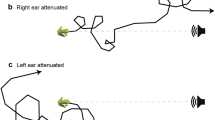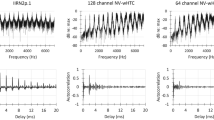Summary
-
1.
Two male great tits (Parus major) were trained to distinguish between sounds from two locations in an operant two alternative, forced choice procedure with positive reinforcement.
-
2.
The angle between the two sound sources, as experienced from the position of the experimental subject, was varied. The angle at which the birds scored 65% correct responses in 60 choices (which corresponds toP = 0.03, two-tailed, binomial test) was defined as the minimum resolvable angle (MRA).
-
3.
The resolution in azimuth for four natural vocalizations, the ‘seeet’ alarm call, the ‘scolding’ call, the mobbing call, and a song element, was 45°, 16°, 20°, and 18°, respectively (Fig. 2). The MRAs correlated well with the results from artificial stimuli with a comparable frequency.
-
4.
MRAs for 300 ms sine wave stimuli were determined from 500 Hz to 8 kHz: The u-shaped function relating MRA with frequency had a minimum at 2 kHz, with a best MRA of 20°. At 500 Hz and 8 kHz the MRAs were 66.5° and 52°, respectively. MRA of a 300 ms white noise stimulus was 20.5° (Fig. 3).
-
5.
The duration of the stimulus had no effect on the resolution in azimuth for a range of durations from 40 ms to 300 ms (Table 1). This suggests that the great tit may locate a sound source in an open loop fashion.
Similar content being viewed by others
Abbreviations
- MRA :
-
minimum resolvable angle
References
Brown CH (1982) Ventriloquial and locatable vocalizations in birds. Z Tierpsychol 59:338–350
Coles RB, Lewis DB, Hill KG, Hutchings ME, Gower M (1980) Directional hearing in the Japanese quail (Coturnix c. japonica). II. Cochlear physiology. J Exp Biol 86:153–170
Dooling RJ (1982) Auditory perception in birds. In: Kroodsma DE, Miller EH (eds) Acoustic communication in birds: Production, perception, and design features of sounds. Academic Press, New York London, pp 95–130
Gatehouse RW, Shelton BR (1978) Sound localization in the bobwhite quail (Colinus virginianus). Behav Biol 22:533–540
Gompertz T (1961) The vocabulary of the Great Tit. Br Birds 54:359–394, 409–418
Granit O (1941) Beiträge zur Kenntnis des Gehörsinns der Vögel. Ornis Fennica 18:49–71
Hinde RA (1952) The behaviour of the great tit (Parus major) and related species. Behav Suppl 2:1–201
Järvi T, Radesater T, Jakobsson S (1977) Individual recognition and variation in the great tit (Parus major). Biophon 5:4–9
Jenkins WM, Masterton RB (1979) Sound localization in the pigeon (Columba livia). J Comp Physiol Psychol 93:403–413
Klump GM (1984) Struktur und Funktion der LuftfeindAlarmrufe der Kohlmeise (Parus major) außerhalb der Brutzeit. Dissertation, Ruhr-University Bochum
Klump GM, Curio E (1983) Why don't spectra of songbirds' vocalizations correspond with the sensitivity maxima of their absolute threshold curves. Verh Dtsch Zool Ges 76:182
Klump GM, Shalter MD (1984) Acoustic behaviour of birds and mammals in the predator context. I. Factors affecting the structure of alarm signals. II. The functional significance of alarm signals and their evolution. Z Tierpsychol 66:189–226
Klump GM, Kretzschmar E, Curio E (1986) The hearing of an avian predator and its avian prey. Behav Ecol Sociobiol 18:317–323
Knudsen EI (1980) Sound localization in birds. In: Popper AN, Fay RR (eds) Comparative studies of hearing in vertebrates. Springer, Berlin Heidelberg New York, pp 289–322
Knudsen EI, Konishi M (1979) Mechanisms of sound localization in the barn owl (Tyto alba). J Comp Physiol 133:13–21
Konishi M (1973) Locatable and nonlocatable acoustic signals for barn owls. Am Nat 107:775–785
Kretzschmar E (1982) Wie hört ein Sperber (Accipiter nisus L.) Alarmrufe seiner Beutevögel? Thesis, Ruhr-University Bochum
Kuhn GF (1977) Model for the interaural time difference in the azimuthal plane. J Acoust Soc Am 62:157–167
Latimer W (1977) A comparative study of the songs and alarm calls of someParus species. Z Tierpsychol 45:414–433
Lewis DB (1983) Directional cues for auditory localization. In: Lewis DB (ed) Bioacoustics, a comparative approach. Academic Press, New York London, pp 233–257
Marler P (1955) Characteristics of some animal calls. Nature 176:6–8
Marler P (1977) The structure of animal communication sounds. In: Bullock T (ed) Dahlem workshop on recognition of complex acoustic signals. Dahlem-Konferenzen, Abakon Verlagsgesellschaft, Berlin, pp 17–35
Moiseff A, Konishi M (1981a) Neuronal and behavioural sensitivity to time differences in the owl. J Neurosci 1:40–48
Moiseff A, Konishi M (1981b) The owl's interaural pathway is not involved in sound localization. J Comp Physiol 144:299–304
Rosowski JJ, Saunders JC (1980) Sound transmission through the avian interaural pathways. J Comp Physiol 136:183–190
Sachs MB, Woolf NK, Sinnot JM (1980) Response properties of neurons in the avian auditory system: Comparisons with mammalian homologues and consideration of neural encoding of complex stimuli. In: Popper AN, Fay RR (eds) Comparative studies of hearing in vertebrates. Springer, Berlin Heidelberg New York, pp 323–353
Schwartzkopff J (1950) Beitrag zum Problem des Richtungshörens bei Vögeln. Z Vergl Physiol 32:319–327
Shalter MD (1978) Localization of passerine seeet and mobbing calls by goshawks and pygmy owls. Z Tierpsychol 46:260–267
Sullivan WE, Konishi M (1984) Segregation of stimulus phase and intensity coding in the cochlear nucleus of the barn owl. J Neurosci 4:1787–1799
Takahashi T, Moiseff A, Konishi M (1984) Time and intensity cues are processed independently in the auditory system of the owl. J Neurosci 4:1781–1786
Wiley RH, Richards DG (1982) Adaptations for acoustic communication in birds: Sound transmission and signal detection. In: Kroodsma DE, Miller EH (eds) Acoustic communication in birds: Production, perception and design features of sounds. Academic Press, New York London, pp 132–181
Windt W (1985) Lokalisation von Kunst- und Naturlauten durch Kohlmeisen (Parus major). Thesis, Ruhr-University Bochum
Woodworth RS (1962) Experimental psychology. Rinehart & Winston, New York, pp 349–361
Author information
Authors and Affiliations
Rights and permissions
About this article
Cite this article
Klump, G.M., Windt, W. & Curio, E. The great tit's (Parus major) auditory resolution in azimuth. J. Comp. Physiol. 158, 383–390 (1986). https://doi.org/10.1007/BF00603622
Accepted:
Issue Date:
DOI: https://doi.org/10.1007/BF00603622




